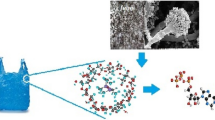Abstract
The biodegradation of fluoranthene, a high molecular weight polycyclic aromatic hydrocarbon (PAH), was investigated in submerged culture using the wood decaying fungus isolated from forest locality in Gujarat, India. The basidiomycete fungal isolate was found to have an ability to grow on sabaroud dextrose agar containing 50 mgl−1 of each naphthalene, anthracene, acenaphthene, benzo (a) anthracene, pyrene, flouranthene, carbazole, and biphenyl. The involvement of extracellular fungal peroxidases such as manganese peroxidase (MnP) and laccase (Phenol oxidase) in the degradation of fluoranthene was studied. On the eighth day of incubation 54.09% of 70 mg l−1 fluoranthene was removed. There after no PAHs removal was observed till the 20th day of the incubation period. The isolate was identified as Pleurotus ostreatus by 18S rRNA, 5.8S rRNA, and partial 28S rRNA gene sequencing. To the best of our knowledge this is the first time Pleurotus ostreatus have been reported to degrade such a high concentration of fluoranthene within much lower time period of incubation. Depletion in the residual fluoranthene in the culture medium was determined by HPLC. Attempts were made to identify the degradation product in the culture medium with the help of FT-IR, NMR, and HPTLC analysis. In the present study positive correlation between fluoranthene degradation and the ligninolytic enzyme (MnP and laccase) production is observed, thus this isolate can play an effective role for bioremediation of PAHs contaminated sites.





Similar content being viewed by others
References
Menzie, C. A., Potocki, B. B., & Santodonato, J. (1992). Environmental Science & Technology, 26, 1278–1284, doi:10.1021/es00031a002.
Nadon, L., Siemiatycki, J., Dewar, R., Krewaski, D., & Guerin, M. (1995). American Journal of Industrial Medicine, 28, 303–324, doi:10.1002/ajim.4700280302.
Christian, K., & Juan, M. L. (1997). Biotechnology Letters, 16, 759–764.
Giraud, F., Giraud, P., Kadri, M., Blake, G., & Steiman, R. (2001). Water Research, 35, 4126–4136, doi:10.1016/S0043-1354(01)00137-3.
Guerin, T. F. (1999). Journal of Hazardous Materials, B65, 305–315, doi:10.1016/S0304-3894(99)00002-3.
Chaudhary, G. R. (1994). Biological degradation and bioremediation of toxic chemicals. Portland, OR, USA: Dioscorides Press.
Cerniglia, C. E. (1993). Current Opinion in Biotechnology, 4, 331–338, doi:10.1016/0958-1669(93)90104-5.
Harayama, S. (1997). Current Opinion in Biotechnology, 8, 268–273, doi:10.1016/S0958-1669(97)80002-X.
Dean-Ross, D., Moody, J. D., Freeman, J. P., Doerge, D. R., & Cerniglia, C. E. (2001). FEMS Microbiology Letters, 204, 205–211, doi:10.1111/j.1574-6968.2001.tb10886.x.
Moody, J. D., Freeman, J. P., Doerge, D. R., & Cerniglia, C. E. (2001). Applied and Environmental Microbiology, 67, 1476–1483, dooi:10.1128/AEM.67.4.1476-483.2001.
Sack, U., & Fritsche, W. (1997). FEMS Microbiology Ecology, 22, 77–83, doi:10.1111/j.1574-941.1997.tb00358.x.
Kelly, I., Freeman, J. P., Evans, F. E., & Cerniglia, C. E. (1993). Applied and Environmental Microbiology, 59, 800–806.
Muncnerova, D., & Augustin, J. (1994). Bioresource Technology, 48, 97–106, doi:10.1016/0960-524(94)90195-3.
Bogan, B. W., & Lamar, R. T. (1996). Applied and Environmental Microbiology, 62, 1597–1603.
Tien, M., & Kirk, T. K. (1988). Methods in Enzymology, 161, 238–249, DOI 10.1016/0076-6879(88)61025-1.
Cerniglia, C. E. (1997). Journal of Industrial Microbiology & Biotechnology, 19, 324–333, DOI 10.1038/sj.jim.2900459.
Schutzendubel, A. M., Majcherczyk, A. Johannes, C., & Hutterman, A. (1999). International Biodeterioration and Biodegradation, 43, 93–100, doi:10.1016/S0964-8305(99)00035-9.
Verdin, A., Lounes-Hadj Sahraoui, A., & Durand, R. (2004). International Biodeterioration and Biodegradation, 53, 65–70, doi:10.1016/j.ibiod.2003.12.001.
Lowry, O. H., Rosebrough, N. J., Farr, A. L., & Randall, R. J. (1951). Journal of Biochemistry, 193, 265–275.
Niku-Paavola, M. L., Raaska, L., & Itavaara, M. (1990). Mycological Research, 94, 27–31.
Martinez, M. J., Ruiz-Duenas, F. J., Guillen, F. A., & Martinez, A. T. (1996). European Journal of Biochemistry, 237, 424–432, doi:10.1111/j.1432-33.1996.0424k.x.
Seigle-Murandi, F., Krivobok, S., Steiman, R., Thiault, G. A., & Benoit-Guyod, J. L. (1991b). Journal of Agricultural and Food Chemistry, 39, 428–430, doi:10.1021/jf00002a041.
Tekere, M., Read, J. S., & Mattiasson, B. (2005). Journal of Biotechnology, 115, 367–377, doi:10.1016/j.jbiotec.2004.09.012.
Collins, P. J., & Dobson, A. D. W. (1996). Biotechnology Letters, 18, 801–804, doi:10.1007/BF00127892.
Dhawale, S. W., Dhawale, S. S., & Ross, D. D. (1999). Applied and Environmental Microbiology, 58, 3000–3006.
Moredo, N., Lorenzo, M., Dominguez, A., Moldes, D., Cameselle, C., & Sanroman, A. (2003). World Journal of Microbiology & Biotechnology, 19, 665–669, doi:10.1023/A:1025198917474.
Morgan, R., Lewis, S. T., & Watkinson, R. J. (1991). Applied Microbiology and Biotechnology, 34, 693–696, doi:10.1007/BF00167925.
Salicis, F., Krivobok, K., Jack, M., & Benoit Guyod, J. L. (1999). Chemo, 38, 3031–3039, doi:10.1016/S0045-535(98)00504-9.
Seigle-Murandi, F., Krivobok, S., Steiman, R., Benoit-Guyod, J. L., & Thiault, G. A. (1991a). Applied Microbial Biotechnology, 34, 436–440.
Joner, E. J., Corgie, S. C., Amellal, N., & Leyval, C. (2002). Soil Biology & Biochemistry, 34, 859–864, doi:10.1016/S0038-0717(02)00018-4.
Novotny, C., Svobodova, K., Erbanova, P., Cajthaml, T., Kasinath, A., Lang, E., et al. (2004). Soil Biology & Biochemistry, 36, 1545–1551, doi:10.1016/j.soilbio.2004.07.019.
Novotny, C., Erbanova, P., Sasek, V., Kubatova, A., Cajthamal, T., Lang, E., et al. (1999). Biodegradation, 10, 159–168, doi:10.1023/A:1008324111558.
Acknowledgement
Financial support from the University Grants Commission (UGC), [Grant No. F.30-181/2004 (SR)], New Delhi, India is gratefully acknowledged.
Author information
Authors and Affiliations
Corresponding author
Rights and permissions
About this article
Cite this article
Patel, H., Gupte, A. & Gupte, S. Biodegradation of Fluoranthene by Basidiomycetes Fungal Isolate Pleurotus Ostreatus HP-1. Appl Biochem Biotechnol 157, 367–376 (2009). https://doi.org/10.1007/s12010-008-8286-0
Received:
Accepted:
Published:
Issue Date:
DOI: https://doi.org/10.1007/s12010-008-8286-0




